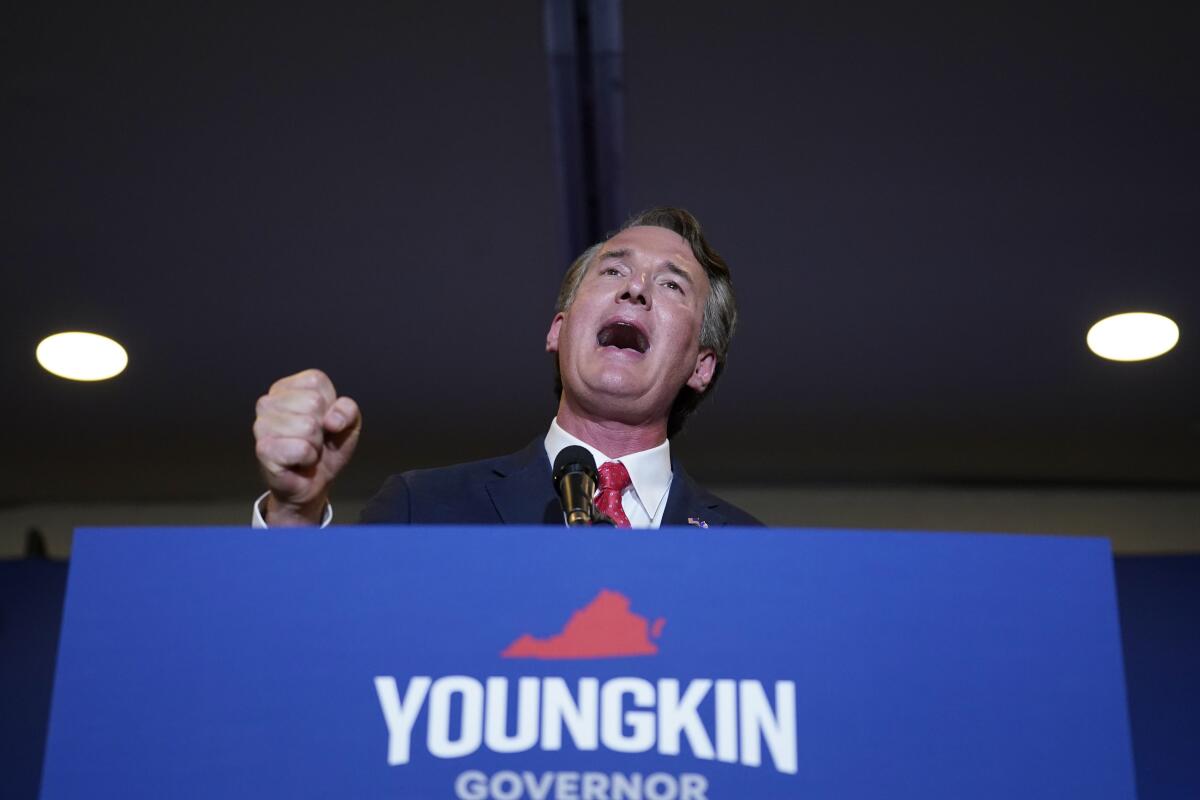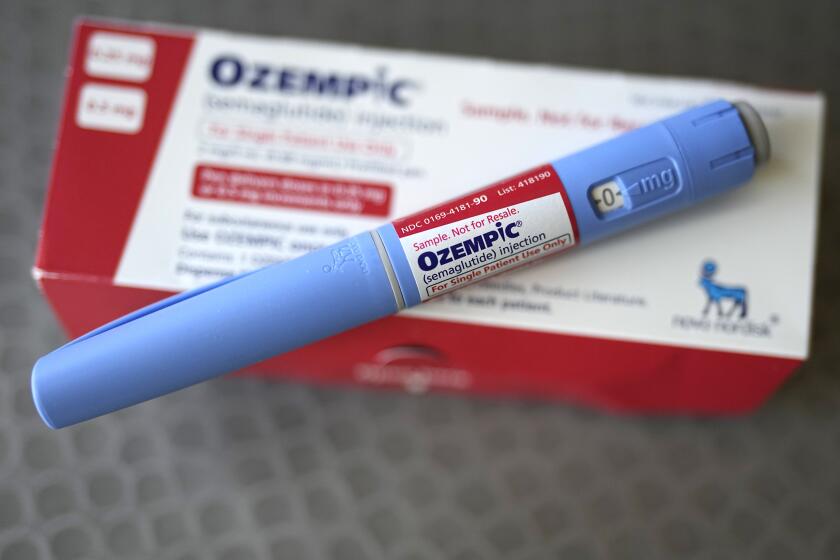The losses in Virginia should be a warning to Democrats everywhere

- Share via
Historic trends are very hard to buck. Like the fact that off-year and midterm elections usually go badly for the party that holds the White House. In Virginia, for example, the candidate of the president’s party almost never wins the race for governor in the year after the presidential election.
Still, Terry McAuliffe — a political pro and successful former governor of Virginia — wouldn’t have run for his old office again if he’d thought he was doomed to lose to Republican Glenn Youngkin. After all, McAuliffe did beat the odds to win in 2013, just after Barack Obama was reelected. But lose he did.
Democrats, who hadn’t experienced defeat in a statewide election in Virginia since 2009, also lost races for lieutenant governor and attorney general, as well as control of the state House of Delegates. In New Jersey, they barely hung on to the governorship as the race was called for incumbent Gov. Phil Murphy on Wednesday afternoon.
Opinion Columnist
Jackie Calmes
Jackie Calmes brings a critical eye to the national political scene. She has decades of experience covering the White House and Congress.
History offers no solace as Democrats picked through the losses, especially since the same political trend suggests worse ahead: That their party stands to lose control of the House and perhaps the Senate in the 2022 midterms.
Predictably, Democrats formed a circular firing squad to consider what went so wrong. Amid the Afghanistan withdrawal debacle, supply-chain disruptions, border crises and COVID-19’s persistence, President Biden was an unpopular drag even in blue Virginia and New Jersey, states that he’d won by 10 and 16 percentage points, respectively.
Progressives and moderates blamed each other for Democrats’ infighting, especially over legislation that embodied Biden’s campaign promises. And by their disunity and bad messaging, Democrats allowed themselves to be falsely caricatured as the party of critical race theory and defunding the police instead of paid family leave, lower prescription-drug prices and much-needed infrastructure.
More interesting for the future than what Democrats did wrong, however, was what Republicans — in particular, Youngkin — did right.
Yes, he had the historical winds at his back. Yet by his victory, Youngkin suggested a model for Republican candidates in swing states and districts in threading a difficult political needle: how to be Trumpy enough to mobilize the MAGA army in rural areas while seeming moderate enough to regain the votes of college-educated Republicans and independents in the suburbs, whose disgust with Donald Trump had driven them into the Democrats’ camp in recent years.
The question, though, is whether other Republican candidates in blue or purple states and districts can follow Youngkin’s playbook.
In Virginia, Republican-leaning suburbanites returned to their political comfort zone when given the chance to vote for the mild-mannered financier in his everyman’s red fleece vest and loafers; Youngkin defied McAuliffe’s campaign to define him as Trump 2.0. He still lost to McAuliffe in the suburban counties outside Washington and Richmond, but by far less than Trump did to Biden.
At the same time, Youngkin did even better than Trump in Virginia’s red rural counties. By rolling up votes there while reducing McAuliffe’s haul in the populous but fewer blue counties, Youngkin emerged after midnight as governor-elect.
Of course, Trump took credit even before the race was called. And he deserves some.
Trump was both Youngkin’s greatest potential liability and an asset. He had Trump’s cooperation, it seems, in balancing the two: The Washington Post reported Wednesday that Trump and Youngkin talked repeatedly during the campaign, even as Youngkin treated the former president as He-Who-Must-Not-Be-Named on the campaign trail. Youngkin ended up with the best of all worlds: Lord Voldemort didn’t come to Virginia to spook the suburbanites, yet the former president urged “the MAGA movement” to vote for Youngkin.
Youngkin’s strategy won’t be easily copied.
He was nominated in May over five rivals — not in the more common primary election in which far-right activists dominate, but in a convention engineered to make it harder for the Trumpiest candidates, who’d presumably lose in a general election, to win nomination.
Also, Youngkin is a true political outsider who nonetheless proved to be a good and disciplined candidate, foiling McAuliffe’s effort to morph him into Trump.
Most critically, Trump uncharacteristically followed Republicans’ advice to stay out of Virginia. But Trump isn’t likely to remain quiet and mostly in self-exile at his Florida Mar-a-Lago resort in 2022, especially as he flirts with a campaign of his own in 2024. Already some of his interventions in emerging House and Senate contests have worried party leaders.
But because the results in Virginia as well as New Jersey suggested that Trump has brought new people into the party, mainly white, non-college educated, rural and small town voters, without permanently driving away Republican leaners in the suburbs, Republican Party leaders won’t quit him. Like Youngkin, they’ll continue to indulge Trump as he persists in the Big Lie, with their own talk of “election integrity” and decline to hold him accountable for insurrection.
As for Democrats, they’ve got less than a year now to deliver on their agenda if they have any hope of beating the midterm jinx. The dismayed chair of Virginia’s Democratic Party spoke for a lot of Americans when she said of party leaders on the Potomac’s Washington side: “I would encourage those people across the river — that could pass legislation to give relief to working families — that maybe they better wake up and think about what next year is going to look like now.”
More to Read
A cure for the common opinion
Get thought-provoking perspectives with our weekly newsletter.
You may occasionally receive promotional content from the Los Angeles Times.











